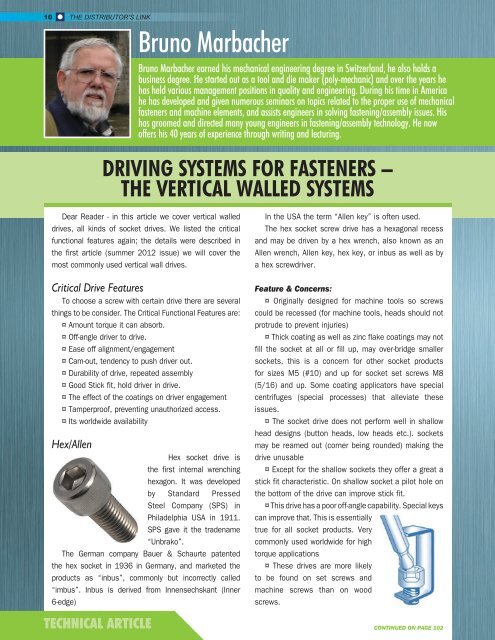FALL 2021
Distributor's Link Magazine Fall 2021 / Vol 44 No 4
Distributor's Link Magazine Fall 2021 / Vol 44 No 4
You also want an ePaper? Increase the reach of your titles
YUMPU automatically turns print PDFs into web optimized ePapers that Google loves.
10<br />
THE DISTRIBUTOR’S LINK<br />
Bruno Marbacher<br />
Bruno Marbacher earned his mechanical engineering degree in Switzerland, he also holds a<br />
business degree. He started out as a tool and die maker (poly-mechanic) and over the years he<br />
has held various management positions in quality and engineering. During his time in America<br />
he has developed and given numerous seminars on topics related to the proper use of mechanical<br />
fasteners and machine elements, and assists engineers in solving fastening/assembly issues. His<br />
has groomed and directed many young engineers in fastening/assembly technology. He now<br />
offers his 40 years of experience through writing and lecturing.<br />
DRIVING SYSTEMS FOR FASTENERS –<br />
THE VERTICAL WALLED SYSTEMS<br />
Dear Reader - in this article we cover vertical walled<br />
drives, all kinds of socket drives. We listed the critical<br />
functional features again; the details were described in<br />
the first article (summer 2012 issue) we will cover the<br />
most commonly used vertical wall drives.<br />
Critical Drive Features<br />
To choose a screw with certain drive there are several<br />
things to be consider. The Critical Functional Features are:<br />
¤ Amount torque it can absorb.<br />
¤ Off-angle driver to drive.<br />
¤ Ease off alignment/engagement<br />
¤ Cam-out, tendency to push driver out.<br />
¤ Durability of drive, repeated assembly<br />
¤ Good Stick fit, hold driver in drive.<br />
¤ The effect of the coatings on driver engagement<br />
¤ Tamperproof, preventing unauthorized access.<br />
¤ Its worldwide availability<br />
Hex/Allen<br />
Hex socket drive is<br />
the first internal wrenching<br />
hexagon. It was developed<br />
by Standard Pressed<br />
Steel Company (SPS) in<br />
Philadelphia USA in 1911.<br />
SPS gave it the tradename<br />
“Unbrako”.<br />
The German company Bauer & Schaurte patented<br />
the hex socket in 1936 in Germany, and marketed the<br />
products as “inbus”, commonly but incorrectly called<br />
“imbus”. Inbus is derived from Innensechskant (Inner<br />
6-edge)<br />
TECHNICAL ARTICLE<br />
In the USA the term “Allen key” is often used.<br />
The hex socket screw drive has a hexagonal recess<br />
and may be driven by a hex wrench, also known as an<br />
Allen wrench, Allen key, hex key, or inbus as well as by<br />
a hex screwdriver.<br />
Feature & Concerns:<br />
¤ Originally designed for machine tools so screws<br />
could be recessed (for machine tools, heads should not<br />
protrude to prevent injuries)<br />
¤ Thick coating as well as zinc flake coatings may not<br />
fill the socket at all or fill up, may over-bridge smaller<br />
sockets, this is a concern for other socket products<br />
for sizes M5 (#10) and up for socket set screws M8<br />
(5/16) and up. Some coating applicators have special<br />
centrifuges (special processes) that alleviate these<br />
issues.<br />
¤ The socket drive does not perform well in shallow<br />
head designs (button heads, low heads etc.). sockets<br />
may be reamed out (corner being rounded) making the<br />
drive unusable<br />
¤ Except for the shallow sockets they offer a great a<br />
stick fit characteristic. On shallow socket a pilot hole on<br />
the bottom of the drive can improve stick fit.<br />
¤ This drive has a poor off-angle capability. Special keys<br />
can improve that. This is essentially<br />
true for all socket products. Very<br />
commonly used worldwide for high<br />
torque applications<br />
¤ These drives are more likely<br />
to be found on set screws and<br />
machine screws than on wood<br />
screws.<br />
CONTINUED ON PAGE 102
















